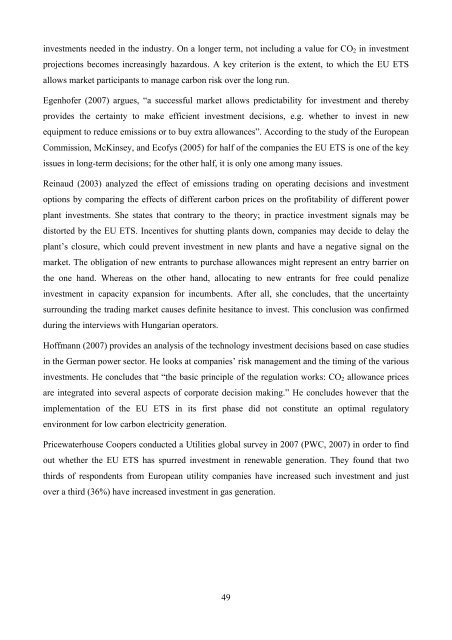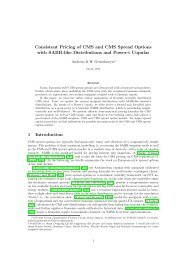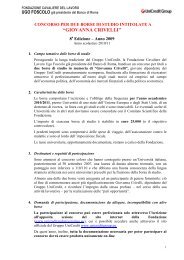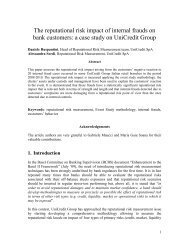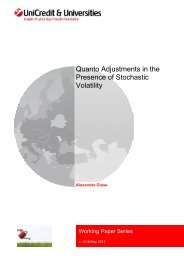Dóra Fazekas Carbon Market Implications for new EU - UniCredit ...
Dóra Fazekas Carbon Market Implications for new EU - UniCredit ...
Dóra Fazekas Carbon Market Implications for new EU - UniCredit ...
Create successful ePaper yourself
Turn your PDF publications into a flip-book with our unique Google optimized e-Paper software.
investments needed in the industry. On a longer term, not including a value <strong>for</strong> CO2 in investment<br />
projections becomes increasingly hazardous. A key criterion is the extent, to which the <strong>EU</strong> ETS<br />
allows market participants to manage carbon risk over the long run.<br />
Egenhofer (2007) argues, “a successful market allows predictability <strong>for</strong> investment and thereby<br />
provides the certainty to make efficient investment decisions, e.g. whether to invest in <strong>new</strong><br />
equipment to reduce emissions or to buy extra allowances”. According to the study of the European<br />
Commission, McKinsey, and Ecofys (2005) <strong>for</strong> half of the companies the <strong>EU</strong> ETS is one of the key<br />
issues in long-term decisions; <strong>for</strong> the other half, it is only one among many issues.<br />
Reinaud (2003) analyzed the effect of emissions trading on operating decisions and investment<br />
options by comparing the effects of different carbon prices on the profitability of different power<br />
plant investments. She states that contrary to the theory; in practice investment signals may be<br />
distorted by the <strong>EU</strong> ETS. Incentives <strong>for</strong> shutting plants down, companies may decide to delay the<br />
plant’s closure, which could prevent investment in <strong>new</strong> plants and have a negative signal on the<br />
market. The obligation of <strong>new</strong> entrants to purchase allowances might represent an entry barrier on<br />
the one hand. Whereas on the other hand, allocating to <strong>new</strong> entrants <strong>for</strong> free could penalize<br />
investment in capacity expansion <strong>for</strong> incumbents. After all, she concludes, that the uncertainty<br />
surrounding the trading market causes definite hesitance to invest. This conclusion was confirmed<br />
during the interviews with Hungarian operators.<br />
Hoffmann (2007) provides an analysis of the technology investment decisions based on case studies<br />
in the German power sector. He looks at companies’ risk management and the timing of the various<br />
investments. He concludes that “the basic principle of the regulation works: CO2 allowance prices<br />
are integrated into several aspects of corporate decision making.” He concludes however that the<br />
implementation of the <strong>EU</strong> ETS in its first phase did not constitute an optimal regulatory<br />
environment <strong>for</strong> low carbon electricity generation.<br />
Pricewaterhouse Coopers conducted a Utilities global survey in 2007 (PWC, 2007) in order to find<br />
out whether the <strong>EU</strong> ETS has spurred investment in re<strong>new</strong>able generation. They found that two<br />
thirds of respondents from European utility companies have increased such investment and just<br />
over a third (36%) have increased investment in gas generation.<br />
49


